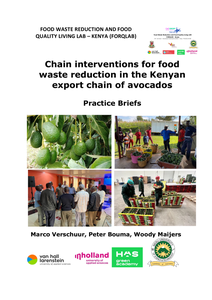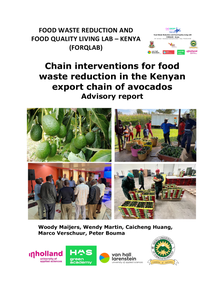This booklet presents the practice briefs (popular papers) of master and bachelor theses and business assignments of students at three Dutch Universities of Applied Sciences: Van Hall Larenstein (VHL), InHolland and HAS Green Academy, and Meru University of Science and Technology in Kenya. All theses and business assignments were commissioned through the researchproject entitled “Food Waste Reduction and Food Quality Living Lab (FORQLAB)” in Kenya.
DOCUMENT

This publication the avocado advisory report which is based on popular papers (practice briefs) of master and bachelor theses and business assignments of students at three Dutch Universities of Applied Sciences: Van Hall Larenstein (VHL), InHolland and HAS Green Academy, and Meru University of Science and Technology in Kenya. All 23 theses and business assignments were commissioned through the research project entitled “Food Waste Reduction and Food Quality LivingLab (FORQLAB)” in Kenya.
DOCUMENT

In this masterclass, Suzanne Klein-Gebbink, program manager of Circular Living Lab Food Valley and Lector Eric de Bruin from Aeres explain about food waste in practice: when is food wasted, why we should reduce it and how value can be created from food waste using the ladder of Lansink, which shows the value hierarchy of what we can do with food waste. Together Eric and Suzanne show examples of projects that look at different ways of creating value from food waste.
DOCUMENT

It is of utmost importance to collect organic waste from households as a separate waste stream. If collected separately, it could be used optimally to produce compost and biogas, it would not pollute fractions of materials that can be recovered from residual waste streams and it would not deteriorate the quality of some materials in residual waste (e.g. paper). In rural areas with separate organic waste collection systems, large quantities of organic waste are recovered. However, in the larger cities, only a small fraction of organic waste is recovered. In general, citizens dot not have space to store organic waste without nuisances of smell and/or flies. As this has been the cause of low organic waste collection rates, collection schemes have been cut, which created a further negative impact. Hence, additional efforts are required. There are some options to improve the organic waste recovery within the current system. Collection schemes might be improved, waste containers might be adapted to better suit the needs, and additional underground organic waste containers might be installed in residential neighbourhoods. There are persistent stories that separate organic waste collection makes no sense as the collectors just mix all municipal solid waste after collection, and incinerate it. Such stories might be fuelled by the practice that batches of contaminated organic waste are indeed incinerated. Trust in the system is important. Food waste is often regarded as unrein. Users might hate to store food waste in their kitchen that could attract insects, or the household pets. Hence, there is a challenge for socio-psychological research. This might also be supported by technology, e.g. organic waste storage devices and measures to improve waste separation in apartment buildings, such as separate chutes for waste fractions. Several cities have experimented with systems that collect organic wastes by the sewage system. By using a grinder, kitchen waste can be flushed into the sewage system, which in general produces biogas by the fermentation of sewage sludge. This is only a good option if the sewage is separated from the city drainage system, otherwise it might create water pollution. Another option might be to use grinders, that store the organic waste in a tank. This tank could be emptied regularly by a collection truck. Clearly, the preferred option depends on local conditions and culture. Besides, the density of the area, the type of sewage system and its biogas production, and the facilities that are already in place for organic waste collection are important parameters. In the paper, we will discuss the costs and benefits of future organic waste options and by discussing The Hague as an example.
DOCUMENT

Purpose: Food waste occurs in every stage of the supply chain, but the value-added lost to waste is the highest when consumers waste food. The purpose of this paper is to understand the food waste behaviour of consumers to support policies for minimising food waste. Design/methodology/approach: Using the theory of planned behaviour (TPB) as a theoretical lens, the authors design a questionnaire that incorporates contextual factors to explain food waste behaviour. The authors test two models: base (four constructs of TPB) and extended (four constructs of TPB plus six contextual factors). The authors build partial least squares structural equation models to test the hypotheses. Findings: The data confirm significant relationships between food waste and contextual factors such as motives, financial attitudes, planning routines, food surplus, social relationships and Ramadan. Research limitations/implications: The data comes from an agriculturally resource-constrained country: Qatar. Practical implications: Food waste originating from various causes means more food should flow through the supply chains to reach consumers’ homes. Contextual factors identified in this work increase the explanatory power of the base model by 75 per cent. Social implications: Changing eating habits during certain periods of the year and food surplus have a strong impact on food waste behaviour. Originality/value: A country is considered to be food secure if it can provide its citizens with stable access to sufficient, safe and nutritious food. The findings and conclusions inform and impact upon the development of food waste and food security policies.
MULTIFILE
In this masterclass, Fontys teacher-researcher Jos Pieterse explains human behaviour concerning creating food waste (throwing away good food) using behaviour models such as Dynamo and Triade. Presented are also a list of questions that can be used to assess a person’s willingness to change his/her behaviour.
DOCUMENT

From the article: "ABSTRACT: The research group Supply Chain Redesign in the Built Environment of HU University of Applied Sciences is working on research that combines principles of the circular economy with open source architectural design & urban planning. The aim is finding new ways to re-use demolition waste and recycled materials in small scale urban area developments. And to “democratize” traditional processes in the built environment. Different recent studies have shown the potential benefits, such as a reduction of emissions. In “Hof van Cartesius”, a practical case-study in Utrecht, the ambitions and implications of this approach are being questioned, investigated and tested."
DOCUMENT

PurposeFood waste is one of the most challenging issues humanity is currently facing. Therefore, there has been a growing interest in the prevention of food waste because of world hunger, environmental impacts, resource scarcity and economic costs. The purpose of the study is to investigate the factors that influence food waste and the role of technology in tackling food waste in India and the Netherlands.Design/methodology/approachIn order to explore differences in food loss and waste further this study will examine a number of practices on both the production and the consumer side, in a developing country and a developed country with different culture/economic backgrounds: India and the Netherlands. The factors that influence food waste were examined with a preliminary qualitative study, which consists of semi-structured interviews, and quantitative research that comprises a survey. Semi-structured interviews were conducted in both India and the Netherlands, which consists of five interviews. The survey data was collected from 78 individuals from India and 115 individuals from the Netherlands.FindingsOne of the main findings of the research is food waste is divided into waste within agricultural production (i.e. food loss) and final household consumption (i.e. food waste). Different factors influence food loss in different stages in the supply chain. Some of these factors include wastage during processing, storage, transportation and at the market-place. New technologies can utilize food loss for new purposes, so food loss is reduced to the minimum. Food waste is mainly influenced by food passing expiry date, food that is left too long in the fridge and consumers buying too much food. In final household consumption, technologies such as digital platforms enable individuals or organizations to share and donate their food, thereby creating awareness on food waste prevention and the environmental and ethical benefits.Originality/valueThe authors examine to what extent and in which ways supporting consumers to minimize food waste can be achieved via three stages: (1) understanding and evaluating food loss and waste, (2) identifying the factors that influence food loss and waste, (3) understanding consumer behaviors to encourage food waste reduction and (4) identifying the technological impact that would reduce food waste. As such, this paper contributes to ongoing debates about food waste by looking at the role of context and culture and by exploring differences between developed and developing countries. Also, the authors advance the debate by exploring both the role of advanced technology such as blockchain and drones in both preventing loss and waste as well as non-technological mechanisms.
DOCUMENT
From a circular standpoint it is interesting to reuse as much as possible construction and demolition waste (CDW) into new building projects. In most cases CDW will not be directly reusable and will need to be processed and stored first. In order to turn this into a successful business case CDW will need to be reused on a large scale. In this paper we present the concept of a centralized and coordinated location in the City of Utrecht where construction and demolition waste is collected, sorted, worked, stored for reuse, or shipped elsewhere for further processing in renewed materials. This has expected advantages for the amount of material reuse, financial advantages for firms and clients, generating employability in the logistics and processing of materials, optimizing the transport and distribution of materials through the city, and thus the reduction of emissions and congestion. In the paper we explore the local facility of a Circular Hub, and the potential effects on circular reuse, and other effects within the City of Utrecht.
DOCUMENT

With this project we strived to contribute to structural reduction of post-harvest food losses and food quality improvement in the Kenyan avocado and dairy value chains through the application of technical solutions and tools as well as improved coordination in those food chains. The consortium had four types of partners: 1. Universities (2 Kenyan, 4 Dutch), 2. Private sector actorsin those chains, 3. Organisations supporting those chains, and 4. Network partners. The applied research has been implemented in cooperation with all partners, whereby students at involved universities conducted most of the field studies and all other consortium partners support and interact depending on the phases.The FORQLAB project targeted two areas in Kenya for both commodities, a relatively well-developed chain in the central highlands and a less-develop chain in Western-Kenya. The research methods were the business to business and multi-stakeholder (living lab) approaches to increase the potential for uptake of successful interventions in the chain. The project consisted of four phases: 1. Inventory and inception, 2. Applied research, 3. Spreading research outputs through living lab networks, 4. Translation of project output in curricula and trainings. The outcomes were: two knowledge exchange platforms (Living Labs) supported with some advice for sustainable food loss reduction, a research agenda, proposals for ICT and other tech solutions and an implementation strategy; communication and teaching materials for universities and TVETs; and knowledge transfer and uptake.
DOCUMENT
